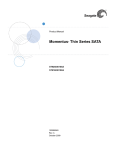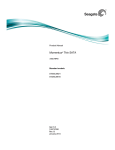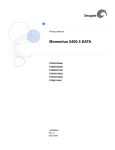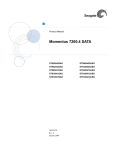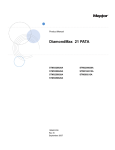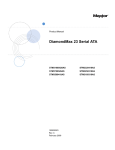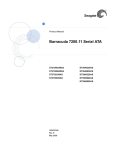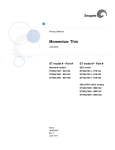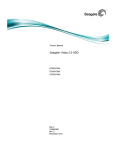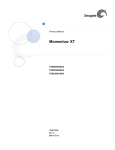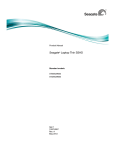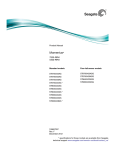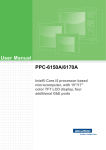Download Seagate Momentus Thin
Transcript
Product Manual Momentus Thin ® 5400-RPM ST model # - Part # Standard models ST320LT020 - 9YG142 ST250LT003 - 9YG14C ST160LT003 - 9YG141 100636119 Rev. E June 2011 Revision history Revision Rev. A Rev. B Rev. C Rev. D Rev. E Date 09/23/10 12/14/10 03/04/11 05/10/11 06/30/11 Sheets affected or comments Initial release. 8. 2, 4, 7 & 18-19. 25-26. 5, 14 & backcover. © 2011 Seagate Technology LLC. All rights reserved. Publication number: 100636119, Rev. E June 2011 Seagate, Seagate Technology and the Wave logo are registered trademarks of Seagate Technology LLC in the United States and/or other countries. Momentus and SeaTools are either trademarks or registered trademarks of Seagate Technology LLC or one of its affiliated companies in the United States and/or other countries. All other trademarks or registered trademarks are the property of their respective owners. No part of this publication may be re produced in any fo rm without written permission of Seagate Technology LLC. Call 877-PUB-TEK1 (877-782-8351) to request permission. One gigabyte, or GB, equals one billion bytes and one terabyte, or TB, equals one trillion by tes. Your computer's operating system may use a different standard of measurement and report a lower capacity. In addition, some of the listed capacity is used for formatting and other functions, and thus will not be available for data storage. Seagate reserves the right to change, without notice, product offerings or specifications. Contents 1.0 Seagate Technology support services . . . . . . . . . . . . . . . . . . . . . . . . . . . . . . . . . . . . . . . . . . . . . 1 2.0 Introduction. . . . . . . . . . . . . . . . . . . . . . . . . . . . . . . . . . . . . . . . . . . . . . . . . . . . . . . . . . . . . . . . . . . 2 2.1 About the Serial ATA interface . . . . . . . . . . . . . . . . . . . . . . . . . . . . . . . . . . . . . . . . . . . . . . 3 3.0 Drive specifications . . . . . . . . . . . . . . . . . . . . . . . . . . . . . . . . . . . . . . . . . . . . . . . . . . . . . . . . . . . . 4 3.1 Specification summary table . . . . . . . . . . . . . . . . . . . . . . . . . . . . . . . . . . . . . . . . . . . . . . . . 4 3.2 Formatted capacity . . . . . . . . . . . . . . . . . . . . . . . . . . . . . . . . . . . . . . . . . . . . . . . . . . . . . . . 6 3.2.1 LBA mode . . . . . . . . . . . . . . . . . . . . . . . . . . . . . . . . . . . . . . . . . . . . . . . . . . . . . . 6 3.3 Default logical geometry . . . . . . . . . . . . . . . . . . . . . . . . . . . . . . . . . . . . . . . . . . . . . . . . . . . 6 3.4 Physical organization. . . . . . . . . . . . . . . . . . . . . . . . . . . . . . . . . . . . . . . . . . . . . . . . . . . . . . 6 3.5 Recording and interface technology . . . . . . . . . . . . . . . . . . . . . . . . . . . . . . . . . . . . . . . . . . 7 3.6 Physical characteristics . . . . . . . . . . . . . . . . . . . . . . . . . . . . . . . . . . . . . . . . . . . . . . . . . . . 7 3.7 Seek time. . . . . . . . . . . . . . . . . . . . . . . . . . . . . . . . . . . . . . . . . . . . . . . . . . . . . . . . . . . . . . . 7 3.8 Start/stop times . . . . . . . . . . . . . . . . . . . . . . . . . . . . . . . . . . . . . . . . . . . . . . . . . . . . . . . . . . 8 3.9 Power specifications . . . . . . . . . . . . . . . . . . . . . . . . . . . . . . . . . . . . . . . . . . . . . . . . . . . . . . 8 3.9.1 Power consumption . . . . . . . . . . . . . . . . . . . . . . . . . . . . . . . . . . . . . . . . . . . . . . . 8 3.9.2 Deferred spinup . . . . . . . . . . . . . . . . . . . . . . . . . . . . . . . . . . . . . . . . . . . . . . . . . . 9 3.9.3 Conducted noise . . . . . . . . . . . . . . . . . . . . . . . . . . . . . . . . . . . . . . . . . . . . . . . . . 9 3.9.4 Voltage tolerance . . . . . . . . . . . . . . . . . . . . . . . . . . . . . . . . . . . . . . . . . . . . . . . . . 9 3.9.5 Power-management modes . . . . . . . . . . . . . . . . . . . . . . . . . . . . . . . . . . . . . . . . 10 3.10 Environmental specifications . . . . . . . . . . . . . . . . . . . . . . . . . . . . . . . . . . . . . . . . . . . . . . . 11 3.10.1 Ambient temperature . . . . . . . . . . . . . . . . . . . . . . . . . . . . . . . . . . . . . . . . . . . . . 11 3.10.2 Temperature gradient. . . . . . . . . . . . . . . . . . . . . . . . . . . . . . . . . . . . . . . . . . . . . 11 3.10.3 Humidity . . . . . . . . . . . . . . . . . . . . . . . . . . . . . . . . . . . . . . . . . . . . . . . . . . . . . . . 11 3.10.4 Altitude . . . . . . . . . . . . . . . . . . . . . . . . . . . . . . . . . . . . . . . . . . . . . . . . . . . . . . . . 11 3.10.5 Shock . . . . . . . . . . . . . . . . . . . . . . . . . . . . . . . . . . . . . . . . . . . . . . . . . . . . . . . . . 12 3.10.6 Vibration . . . . . . . . . . . . . . . . . . . . . . . . . . . . . . . . . . . . . . . . . . . . . . . . . . . . . . . 12 3.11 Acoustics . . . . . . . . . . . . . . . . . . . . . . . . . . . . . . . . . . . . . . . . . . . . . . . . . . . . . . . . . . . . . . 13 3.12 Electromagnetic immunity . . . . . . . . . . . . . . . . . . . . . . . . . . . . . . . . . . . . . . . . . . . . . . . . . 13 3.13 Reliability . . . . . . . . . . . . . . . . . . . . . . . . . . . . . . . . . . . . . . . . . . . . . . . . . . . . . . . . . . . . . 14 3.14 Agency certification . . . . . . . . . . . . . . . . . . . . . . . . . . . . . . . . . . . . . . . . . . . . . . . . . . . . . . 14 3.14.1 Safety certification . . . . . . . . . . . . . . . . . . . . . . . . . . . . . . . . . . . . . . . . . . . . . . . 14 3.14.2 Electromagnetic compatibility. . . . . . . . . . . . . . . . . . . . . . . . . . . . . . . . . . . . . . . 14 3.14.3 FCC verification . . . . . . . . . . . . . . . . . . . . . . . . . . . . . . . . . . . . . . . . . . . . . . . . . 15 3.15 Environmental protection . . . . . . . . . . . . . . . . . . . . . . . . . . . . . . . . . . . . . . . . . . . . . . . . . . 16 3.15.1 European Union Restriction of Hazardous Substances (RoHS) . . . . . . . . . . . . 16 3.15.2 China Restriction of Hazardous Substances (RoHS) Directive . . . . . . . . . . . . . 16 3.16 Corrosive environment . . . . . . . . . . . . . . . . . . . . . . . . . . . . . . . . . . . . . . . . . . . . . . . . . . . 16 4.0 Configuring and mounting the drive . . . . . . . . . . . . . . . . . . . . . . . . . . . . . . . . . . . . . . . . . . . . . 4.1 Handling and static-discharge precautions . . . . . . . . . . . . . . . . . . . . . . . . . . . . . . . . . . . . 4.2 Configuring the drive . . . . . . . . . . . . . . . . . . . . . . . . . . . . . . . . . . . . . . . . . . . . . . . . . . . . . 4.3 Serial ATA cables and connectors . . . . . . . . . . . . . . . . . . . . . . . . . . . . . . . . . . . . . . . . . . 4.4 Drive mounting . . . . . . . . . . . . . . . . . . . . . . . . . . . . . . . . . . . . . . . . . . . . . . . . . . . . . . . . . 17 17 17 18 18 5.0 Serial ATA (SATA) interface . . . . . . . . . . . . . . . . . . . . . . . . . . . . . . . . . . . . . . . . . . . . . . . . . . . . 5.1 Hot-Plug compatibility . . . . . . . . . . . . . . . . . . . . . . . . . . . . . . . . . . . . . . . . . . . . . . . . . . . . 5.2 Serial ATA device plug connector pin definitions. . . . . . . . . . . . . . . . . . . . . . . . . . . . . . . . 5.3 Supported ATA commands . . . . . . . . . . . . . . . . . . . . . . . . . . . . . . . . . . . . . . . . . . . . . . . . 5.3.1 Identify Device command. . . . . . . . . . . . . . . . . . . . . . . . . . . . . . . . . . . . . . . . . . 5.3.2 Set Features command . . . . . . . . . . . . . . . . . . . . . . . . . . . . . . . . . . . . . . . . . . . 5.3.3 S.M.A.R.T. commands . . . . . . . . . . . . . . . . . . . . . . . . . . . . . . . . . . . . . . . . . . . . 20 20 20 22 24 27 28 Momentus Thin Product Manual, Rev. E i ii Momentus Thin Product Manual, Rev. E List of Figures Figure 1. Figure 2. Figure 3. Figure 4. Typical +5V only startup and operation current profile . . . . . . . . . . . . . . . . . . . . . . . . . . . . . . . 9 Serial ATA connectors . . . . . . . . . . . . . . . . . . . . . . . . . . . . . . . . . . . . . . . . . . . . . . . . . . . . . . 17 Attaching SATA cabling . . . . . . . . . . . . . . . . . . . . . . . . . . . . . . . . . . . . . . . . . . . . . . . . . . . . . 18 Mounting dimensions (for standard models) — top, side and end view . . . . . . . . . . . . . . . . . 19 Momentus Thin Product Manual, Rev. E iii 1.0 Seagate Technology support services SEAGATE ONLINE SUPPORT and SERVICES For information regarding products and services, visit http://www.seagate.com/www/en-us/about/contact_us/ Available services include: Presales & Technical support Global Support Services telephone numbers & business hours Authorized Service Centers For information regarding Warranty Support, visit http://www.seagate.com/www/en-us/support/warranty_&_returns_assistance For information regarding Data Recovery Services, visit http://www.i365.com For Seagate OEM & Distribution partner portal, visit https://direct.seagate.com/portal/system For Seagate reseller portal, visit http://spp.seagate.com Momentus Thin Product Manual, Rev. E 1 2.0 Introduction This manual describes the functional, mechanical and interface specifications for the following Seagate Momentus® Thin model drives: ST model # Part # Standard models ST320LT020 9YG142 ST250LT003 9YG14C ST160LT003 9YG141 These drives provide the following key features: • 5400-RPM spindle speed. • 16MB buffer. • Quiet operation. Fluid Dynamic Bearing (FDB) motor. • High instantaneous (burst) data-transfer rates (up to 3Gb/s). • Perpendicular recording technology. • State-of-the-art cache and on-the-fly error-correction algorithms. • Native Command Queuing (NCQ) with command ordering. • Full-track multiple-sector transfer capability without local processor intervention. • 1000 Gs nonoperating shock and 350 Gs of operating shock. • SeaTools diagnostic software performs a drive self-test that eliminates unnecessary drive returns. • The 3D Defense System™, which includes Drive Defense, Data Defense and Diagnostic Defense, offers the industry’s most comprehensive protection for disk drives. • Support for S.M.A.R.T. drive monitoring and reporting. • Support for Read Multiple and Write Multiple commands. 2 Momentus Thin Product Manual, Rev. E 2.1 About the Serial ATA interface The Serial ATA interface provides several advantages over the traditional (parallel) ATA interface. The primary advantages include: • Easy installation and configuration with true plug-and-play connectivity. It is not normally necessary to set any jumpers or other configuration options. • Thinner and more flexible cabling for improved enclosure airflow and ease of installation. • Scalability to higher performance levels. In addition, Serial ATA makes the transition from parallel ATA easy by providing legacy software support. Serial ATA was designed to allow you to install a Serial ATA host adapter and Serial ATA disk drive in your current system and expect all of your existing applications to work as normal. The Serial ATA interface connects each disk drive in a point-to-point configuration with the Serial ATA host adapter. There is no master/slave relationship with Se rial ATA devices like there is with parallel ATA. If tw o drives are attached on one Serial ATA host adapter, the host operating system views the two devices as if they were both “masters” on two separate ports. This essentially means both drives behave as if they are Device 0 (master) devices. Note. The host adapter may, optionally, emulate a master/slave environment to host software where two devices on separate Serial ATA ports are represented to host software as a Device 0 (master) and Device 1 (slave) accessed at the same set of host bus addresses. A host adapter that emulates a master/slave environment manages two sets of shadow registers. This is not a typical Serial ATA environment. The Serial ATA host adapter and drive share the function of emulating parallel ATA device behavior to provide backward compatibility with existing host systems and software. The Command and Control Block registers, PIO and DMA data transfers, resets, and interrupts are all emulated. The Serial ATA host adapter contains a set of registers that shadow the contents of the traditional device registers, referred to as the Shadow Register Block. All Serial ATA devices behave like Device 0 devices. For additional information about how Serial ATA emulates parallel ATA, refer to the “Serial ATA: High Speed Serialized AT Attachment” specification. The specification can be downloaded from http://www.serialata.org. Momentus Thin Product Manual, Rev. E 3 3.0 Drive specifications Unless otherwise noted, all specifications are measured under ambient conditions, at 25°C, and nominal power. For convenience, the phrases the drive and this drive are used throughout this manual to indicate all models. 3.1 Specification summary table The specifications listed in this table are for quick reference. For details on specification measurement or definition, see the appropriate section of this manual Table 1: Drive specifications Drive specification ST320LT020 - 9YG142 ST250LT003 - 9YG14C ST160LT003 - 9YG141 Formatted capacity (GB)* 320 250 160 488,397,168 312,581,808 Guaranteed logical blocks (LBA) 625,142,448 Bytes per physical sector 4096 Physical read/write heads 2 Disks 1 Cache (MB) 16 Recording density in BPI (bits/in avg) 1397k Track density TPI (tracks/in avg) 315k Areal density (Gb/in2 avg) 425 Spindle speed (RPM) 5400 Average latency (ms) 5.6 Internal transfer rate (Mb/s max) 1044 I/O data transfer rate (Gb/s max) 3.0 ATA data-transfer modes supported SATA 1.0, Serial ATA Revision 2.6 PIO modes 0–4 Multiword DMA modes 0–2 Ultra DMA modes 0–6 Height (max) 7.0 mm (0.276 in) Width (max) 70.10 mm (2.76 in) Length (max) 100.55 mm (3.959 in) Weight (max) <92.0 g (<0.203 lb) Power-on to ready (sec typical) 3.5 Standby to ready (sec typical) 3.0 Track-to-track seek time, read (ms typical) 1.5 Average seek, read (ms typical) 11 Startup current, +5V (max) 1.0A Read/write power (typical) Read: 1.30W; Write: 1.65W Idle mode, low power (typical) 0.48W 4 1 Momentus Thin Product Manual, Rev. E Table 1: Drive specifications Drive specification ST320LT020 - 9YG142 ST250LT003 - 9YG14C Standby/Sleep mode (typical) 0.15W *** Voltage tolerance (including noise) +5V ± 10% Ambient temperature 0° to 60°C (operating), –40° to 70°C (nonoperating) Temperature gradient (°C per hour max) 20°C (operating) 35°C (nonoperating) Relative humidity 5% to 95% (operating) 5% to 95% (nonoperating) Relative humidity gradient 30% per hour max Wet bulb temperature (°C max) 37.7 (operating) 40 (nonoperating) Altitude, operating –304.8 m to 3,048 m (–1000 ft. to 10,000+ ft.) Altitude, nonoperating (meters below mean sea level, max) –304.8 m to 12,192 m (–1000 ft. to 40,000+ ft.) Shock, operating (Gs max at 2ms) 350 Shock, nonoperating (Gs max at 2ms) 800 Shock, nonoperating (Gs max at 1ms) 1000 Shock, nonoperating (Gs max at 0.5ms) 600 Vibration, operating (Swept Sine) 1.0 Gs (0 to peak, 5–500 Hz) Vibration, nonoperating 5.0 Gs (0 to peak, 5–500 Hz) ST160LT003 - 9YG141 Drive acoustics, sound power (bels) Idle** 2.0 (typical) 2.2 (max) Seek 2.2 (typical) 2.4 (max) Nonrecoverable read errors 1 per 1014 bits read Annualized Failure Rate (AFR) 0.48% Load/Unload (U/UL) cycles 25°C, 50% relative humidity 600,000 software-controlled power on/off cycles 20,000 hard power on/off cycles 32°C, 80% relative humidity 5°C, 80% relative humidity 5°C, 10% relative humidity 55°C, 16% relative humidity 600,000 software-controlled power on/off cycles 20,000 hard power on/off cycles Warranty To determine the warranty for a specific drive, use a web browser to access the following web page: http://www.seagate.com/www/en-us/support/warranty_&_returns_assistance You will be asked to provide the drive serial number, model number (or part number) and country of purchase. After submitting this information, the system will display the warranty information for your drive. Supports Hotplug operation per Serial ATA Revision 2.6 specification Yes (requires COMRESET from host after a hotplug event) *One GB equals one billion bytes when referring to hard drive capacity. Accessible capacity may vary depending on operating environment and formatting. **During periods of drive idle, some offline activity may occur according to the S.M.A.R.T. specification, which may increase acoustic and power to operational levels. ***Typical notebooks will pull power to the drive when entering S3 and S4; while in the S3 and S4 states, drive sleep and drive standby modes will not contribute to battery power consumption. Momentus Thin Product Manual, Rev. E 5 3.2 Formatted capacity Formatted capacity* Guaranteed logical blocks (LBA) - 512 emulation ST320LT020 - 9YG142 625,142,448 ST250LT003 - 9YG14C 488,397,168 ST160LT003 - 9YG141 312,581,808 Bytes per physical sector 4096 *One GB equals one billion bytes when referring to hard drive capacity. Accessible capacity may vary depending on operating environment and formatting. 3.2.1 LBA mode When addressing these drives in LBA mode, all blocks (sectors) are consecutively numbered from 0 to n–1, where n is the number of guaranteed logical blocks (LBA) as defined above. See Section 5.3.1, "Identify Device command" (words 60-61 and 100-103) for additional information about 48bit addressing support of drives with capacities over 137GB. 3.3 Default logical geometry Cylinders Read/write heads Sectors per track 16,383 16 63 LBA mode When addressing these drives in LBA mode, all blocks (sectors) are consecutively numbered from 0 to n–1, where n is the number of guaranteed logical blocks (LBA) as defined above. 3.4 Physical organization Models 320GB models 250GB models 160GB models 6 Read/write heads 2 Number of disks 1 1 Momentus Thin Product Manual, Rev. E 3.5 Recording and interface technology 4K sector models Interface Serial ATA (SATA) Recording method Perpendicular Recording density BPI (bits/in avg) 1397k Track density TPI (tracks/in avg) 315k Areal density (Gb/in2 avg) 425 Spindle speed (RPM) (± 0.2%) 5400 Maximum Internal transfer rate (Mb/s) 1044 I/O data-transfer rate (Gb/s max) 3.0 Interleave 1:1 Cache buffer 3.6 16MB (16,384 KB) Physical characteristics Drive specification Height (mm) (in) 6.8 +/-0.2 0.268 +/-0.0079 Width (mm) (in) 69.85 +/-0.25 2.75 +/-0.0098 Length (mm) (in) 100.35 +0.20/-0.25 3.951 +0.008/-0.010 Weight (max) 92.0 g 0.203 lb All models 3.7 Seek time Seek measurements are taken with nominal power at 25°C ambient temperature. All times are measured using drive diagnostics. The specifications in the table below are defined as follows: • Track-to-track seek time is an average of all possible single-track seeks in both directions. • Average seek time is a true statistical random average of at least 5000 measurements of seeks between random tracks, less overhead. Table 2: Typical seek times Typical seek times (ms) Read Track-to-track 1.5 Average 11 Average latency 5.6 Note. These drives are designed to consistently meet the seek times represented in this manual. Physical seeks, regardless of mode (s uch as track-to-track and average), are expected to meet the noted values. However, due to th e manner in which these drives are formatted, benchmark tests that include command overhead or measure logical seeks may produce results that vary from these specifications. Momentus Thin Product Manual, Rev. E 7 3.8 Start/stop times Time to ready Typical Max @ 25°C Power-on to Ready (sec) 3.5 4.0 Standby to Ready (sec) 3.0 3.0 3.9 Power specifications The drive receives DC power (+5V) through a native SATA power connector. 3.9.1 Power consumption Power requirements for the drives are listed in the table on page 8. Typical power measurements are based on an average of drives tested, under nominal conditions, at 25°C ambient temperature. These power measurements are done with Interface Power Management modes like HIPM and DIPM enabled. • Spinup power Spinup power is measured from the time of power-on to the time that the drive spindle reaches operating speed. • Seek mode During seek mode, the read/write actuator arm moves toward a specific position on the disk surface and does not execute a read or write operation. Servo electronics are active. Seek mode power is measured based on three random seek operations every 100ms. This mode is not typical. • Read/write power and current Read/write power is measured with the heads on track, based on three 63 sector read or write operations every 100ms. • Idle mode power Idle mode power is measured with the drive up to speed, with servo electronics active and with the heads in a random track location. • Standby mode During Standby mode, the drive accepts commands, but the drive is not spinning, and the servo and read/ write electronics are in power-down model Table 3: DC power Power dissipation +5V input average (25° C) Spinup (max) 1.00A Seek 1.4W Read 1.3W Write 1.65W Idle, performance* 1.1W Idle, active* 0.68W Idle, low power mode* 0.48W Standby** 0.15W Sleep 0.15W *During periods of drive idle, some offline activity may occur according to the S.M.A.R.T. specification, which may increase acoustic and power to operational levels. **Standby power is measured at steady state (after 200ms from transition) 8 Momentus Thin Product Manual, Rev. E 3.9.1.1 Typical current profile Figure 1. Typical +5V only startup and operation current profile 3.9.2 Deferred spinup Momentus Thin drives do not support the deferred spinup option. If you require this option, refer to the Momentus 5400.3 SATA Blade Server family of drives. 3.9.3 Conducted noise Input noise ripple is measured at the host system power supply across an equivalent 15-ohm resistive load on the +5 volt line. Using 5-volt power, the drive is expected to operate with a maximum of 100 mV peak-to-peak square-wave injected noise at up to 30 MHz. Note. Equivalent resistance is calculated by dividing the nominal voltage by the typical RMS read/write current. 3.9.4 Voltage tolerance Voltage tolerance (including noise): 5V ± 10% Momentus Thin Product Manual, Rev. E 9 3.9.5 Power-management modes The drive provides programmable power management to provide greater energy efficiency. In most systems, you can control power management through the system setup program. The d rive features the following power-management modes: Table 4: Power management modes Power modes Heads Spindle Buffer Active (operating) Tracking Rotating Full power Idle, performance Tracking Rotating Self refresh—low power Idle, active Floating Rotating Self refresh—low power Idle, low power Parked Rotating Self refresh—low power Standby Parked Stopped Self refresh—low power Sleep Parked Stopped Self refresh—low power • Active mode The drive is in Active mode during the read/write and seek operations. • Idle mode The buffer remains enabled, and the drive accepts all commands and returns to Active mode any time disk access is necessary. • Standby mode The drive enters Standby mode when the host sends a Standby Immediate command. If the host has set the standby timer, the drive can also enter Standby mode automatically after the drive has been inactive for a specifiable length of time. The standby timer delay is established using a Standby or Idle command. In Standby mode, the drive buffer is in Self Refresh Low Power mode, the heads are parked and the spindle is at rest. The drive accepts all commands and returns to Active mode any time disk access is necessary. • Sleep mode The drive enters Sleep mode after receiving a Sleep command from the host. In Sleep mode, the drive buffer is in Self Refresh Low Power mode, the heads are parked and the spindle is at rest. The drive leaves Sleep mode after it receives a Hard Reset or Soft Reset from the host. After receiving a reset, the drive exits Sleep mode and enters Standby mode with all current translation parameters intact. • Idle and Standby timers Each time the drive performs an Active function (read, write or seek), the standby timer is reinitialized and begins counting down from its specified delay times to ze ro. If the standby timer reaches zero before any drive activity is required, the drive makes a transition to Standby mode. In both Idle and Standby mode, the drive accepts all commands and returns to Active mode when disk access is necessary. 10 Momentus Thin Product Manual, Rev. E 3.10 Environmental specifications 3.10.1 Ambient temperature Ambient temperature is defined as the temperature of the environment immediately surrounding the drive. Above 1000 feet (305 meters), the maximum temperature is derated linearly by 1°C every 1000 feet. Operating: 0° to 60°C (32° to 140°F) Nonoperating: –40° to 70°C (–40° to 158°F) 3.10.2 Temperature gradient Operating 20°C per hour (68°F per hour max), without condensation Nonoperating 35°C per hour (95°F per hour max), without condensation 3.10.3 Humidity 3.10.3.1 Relative humidity Operating 5% to 95% noncondensing (30% per hour max) Nonoperating 5% to 95% noncondensing (30% per hour max) 3.10.3.2 Wet bulb temperature Operating 37.7°C (99.86°F max) Nonoperating 40°C (104°F max) 3.10.4 Altitude Operating –304.8 m to 3,048 m (–1000 ft to 10,000+ ft) Nonoperating –304.8 m to 12,192 m (–1000 ft to 40,000+ ft) Momentus Thin Product Manual, Rev. E 11 3.10.5 Shock All shock specifications assume that the drive is mounted securely with the input shock applied at the drive mounting screws. Shock may be applied in the X, Y or Z axis. 3.10.5.1 Operating shock These drives comply with the performance levels specified in this document when subjected to a maximu m operating shock of 350 Gs based on half-sine shock pulses of 2ms. Shocks should not be repeated more than two times per second. 3.10.5.2 Nonoperating shock The nonoperating shock level that the drive can experience without incurring physical damage or degradation in performance when subsequently put into operation is 800 Gs based on a nonrepetitive half-sine shock pulse of 2ms duration. The nonoperating shock level that the drive can experience without incurring physical damage or degradation in performance when subsequently put into operation is 100 0 Gs ba sed on a nonrepetitive half-sine shock pulse of 1ms duration. The nonoperating shock level that the drive can experience without incurring physical damage or degradation in performance when subsequently put into operation is 600 Gs based on a nonrepetitive half-sine shock pulse of 0.5ms duration. 3.10.6 Vibration All vibration specifications assume that the drive is mo unted securely with the input vibration applied at the drive mounting screws. Vibration may be applied in the X, Y or Z axis. 3.10.6.1 Operating vibration The maximum vibration levels that the drive may experience while meeting the performance standards specified in this document are specified below. 5–500 Hz 3.10.6.2 1.0 Gs (0 to peak). Max displacement may apply below 10Hz. Nonoperating vibration The maximum nonoperating vibration levels that the drive may experience without incurring physical damage or degradation in performance when subsequently put into operation are specified below. 5–500 Hz: 12 5.0 Gs (0 to peak). Max displacement may apply below 22Hz. Momentus Thin Product Manual, Rev. E 3.11 Acoustics Drive emission of sound is measured consistent with the ECMA-74 and its’ referenced standards. Testing is conducted at r oom temperature (approximately 25°C). Emission levels are reported as the total A-weighted sound power levels for steady state, idle, and active seek modes of operation. Table 5: Drive A-weighted Sound Power Levels (SWL, BA) Idle* Performance seek 2.0 bels (typ) 2.2 bels (max) 2.2 bels (typ) 2.4 bels (max) *During periods of drive idle, some offline activity may occur according to the S.M.A.R.T. specification, which may increase acoustic and power to operational levels. Test for Prominent Discrete Tones (PDTs) Seagate follows the ECMA-74 standards for measurement and identification of PDTs. An exception to this process is the use of the absolute threshold of hearing. Seagate uses the lower limit for the threshold curve* to discern tone audibility and to compensate for the inaudible components of sound prior to computation of tone ratios according to Annex D of the ECMA-74 standards. *Defined as the median curve given by ISO 389-7 (Tf curve) minus 10dB at all frequencies. 3.12 Electromagnetic immunity When properly installed in a r epresentative host system, the drive operates without errors or degradation in performance when subjected to the radio frequency (RF) environments defined in the following table: Table 6: Radio frequency environments Test Description Performance level Reference standard Electrostatic discharge Contact, HCP, VCP: ± 4 kV; Air: ± 8 kV B EN 61000-4-2: 95 Radiated RF immunity 80 to 2000 MHz, 10 V/m, 80% AM with 1 kHz sine 900 MHz, 3 V/m, 50% pulse modulation @ 200 Hz A EN 61000-4-3: 96 ENV 50204: 95 Electrical fast transient ± 1 kV on AC mains, ± 0.5 kV on external I/O B EN 61000-4-4: 95 Surge immunity ± 1 kV differential, ± 2 kV common, AC mains B EN 61000-4-5: 95 Conducted RF immunity 150 kHz to 80 MHz, 3 Vrms, 80% AM with 1 kHz sine A EN 61000-4-6: 97 Power Frequency H-field immunity 1 A/m, 50Hz/60Hz, 3 axes A EN 61000-4-8: 97 Voltage dips, interrupts 30% Reduction for 25 cycles >95% Reduction for 250 cycles >95%, 0.5 cycles C C B EN 61000-4-11: 94 Momentus Thin Product Manual, Rev. E 13 3.13 Reliability Measurement type Specification Nonrecoverable read errors 1 per 1014 bits read, max Annualized Failure Rate (AFR) <0.48% Load/Unload (U/UL) 25°C, 50% relative humidity 600,000 software-controlled power on/off cycles 20,000 hard power on/off cycles 32°C, 80% relative humidity 5°C, 80% relative humidity 5°C, 10% relative humidity 55°C, 16% relative humidity 600,000 software-controlled power on/off cycles 20,000 hard power on/off cycles Warranty To determine the warranty for a specific drive, use a web browser to access the following web page: http://www.seagate.com/www/en-us/support/warranty_&_returns_assistance You will be asked to provide the drive serial number, model number (or part number) and country of purchase. After submitting this information, the system will display the warranty information for your drive. 3.14 Agency certification 3.14.1 Safety certification These products are certified to me et the r equirements of UL60 950-1, CSA60950-1 and EN60950 and so marked as to the certify agency. 3.14.2 Electromagnetic compatibility Hard drives that display the CE mark comply with the European Union (EU) requirements specified in the Electromagnetic Compatibility Directive (2004/108/EC) as put into place 20 July 2007. Testing is performed to the levels specified by the product standards for Information Technology Equipment (ITE). Emission levels ar e defined by EN 55022, Class B and the immunity levels are defined by EN 55024. Drives are tested in representative end-user systems. Although CE-marked Seagate drives comply with the directives when used in the test systems, we cannot guarantee that all systems will comply with the directives. The drive is designed for operation inside a properly designed enclosure, with properly shielded I/O cable (if necessary) and terminators on all unused I/O ports. Computer manufacturers and system integrators should confirm EMC compliance and provide CE marking for their products. Korean RRL If these drives have the Korean Communications Commission (KCC) logo, they comply with paragraph 1 of Article 11 of the Electromagnetic Compatibility control Regulation and meet the Electromagnetic Compatibility (EMC) Framework requirements of the Radio Research Laboratory (RRL) Communications Commission, Republic of Korea. These drives have been tested and comply with the Electromagnetic Interference/Electromagnetic Susceptibility (EMI/EMS) for Class B products. Drives are tested in a repr esentative, end-user system by a Korean-recognized lab. • Certificate number: STX-MomentusThin (B) • Trade name or applicant: Seagate Technology LLC • Certificate date: 17 September 2009 • Manufacturer/nationality: USA, Singapore and China 14 Momentus Thin Product Manual, Rev. E Australian C-Tick (N176) If these models have the C- Tick marking, they comply with the Australia/New Zealand Standard AS/NZ CISPR22 and meet the E lectromagnetic Compatibility (EMC) Framework requirements of the A ustralian Communication Authority (ACA). 3.14.3 FCC verification These drives are intended to be contained solely within a personal computer or similar enclosure (not attached as an external device). As such, each drive is considered to be a subassembly even when it is individually marketed to the customer. As a subassembly, no Federal Communications Commission verification or certification of the device is required. Seagate Technology LLC has tested this device in en closures as described above to ensur e that the total assembly (enclosure, disk drive, motherboard, power supply, etc.) does comply with the limits for a C lass B computing device, pursuant to Subpart J, Part 15 of the FCC rules. Operation with noncertified assemblies is likely to result in interference to radio and television reception. Radio and television interference. This equipment generates and uses r adio frequency energy and if n ot installed and used in strict accordance with the manufacturer’s instructions, may cause interference to radio and television reception. This equipment is designed to provide reasonable protection against such interference in a residential installation. However, there is no guarantee that interference will not occur in a particular installation. If this equipment does cause interference to radio or television, which can be determined by turning the equipment on and off, you are encouraged to try one or more of the following corrective measures: • Reorient the receiving antenna. • Move the device to one side or the other of the radio or TV. • Move the device farther away from the radio or TV. • Plug the computer into a different outlet so that the receiver and computer are on different branch outlets. If necessary, you should consult your dealer or an experienced radio/television technician for additional suggestions. You may find helpful the following booklet prepared by the Federal Communications Commission: How to Identify and Resolve Radio-Television Interference Problems. This booklet is available from the Superintendent of Documents, U.S. Government Printing Office, Washington, DC 20402. Refer to publication number 004-000-00345-4. Momentus Thin Product Manual, Rev. E 15 3.15 Environmental protection Seagate designs its products to meet environmental protection requirements worldwide, including regulations restricting certain chemical substances. 3.15.1 European Union Restriction of Hazardous Substances (RoHS) The European Union Restriction of Hazardous Substances (RoHS) Directive, restricts the presence of chemical substances, including Lead, Cadmium, Mercury, Hexavalent Chromium, PBB and PBDE, in electronic products, effective July 2006. This drive is manufactured with components and materials that comply with the RoHS Directive. 3.15.2 China Restriction of Hazardous Substances (RoHS) Directive This product has an En vironmental Protection Use Period (EPUP) o f 20 ye ars. The following table contains information mandated by China's "Marking Requirements for Control of Pollution Caused by Electronic Information Products" Standard. "O" indicates the hazardous and toxic substance content of the part (at the homogenous material level) is lower than the threshold defined by the China RoHS MCV Standard. “O”表示该部件(于同类物品程度上)所含的危险和有毒物质低于中国RoHS MCV标准所定义的门槛值。 "X" indicates the hazardous and toxic substance content of the part (at the homogenous material level) is over the threshold defined by the China RoHS MCV Standard. “X”表示该部件(于同类物品程度上)所含的危险和有毒物质超出中国RoHS MCV标准所定义的门槛值。 3.16 Corrosive environment Seagate electronic drive components pass accelerated corrosion testing equivalent to 10 years exposure to light industrial environments containing sulfurous gases, chlorine and nitric oxide, classes G and H per ASTM B845. However, this accelerated testing cannot duplicate every potential application environment. Users should use caution exposing any electronic components to uncontrolled chemical pollutants and corrosive chemicals as electronic drive component reliability can be affected by the installation environment. The silver, copper, nickel and gold films used in Seagate products are especially sensitive to the presence of sulfide, chloride, and nitrate contaminants. Sulfur is found to be the most damaging. In addition, electronic components should never be exposed to condensing water on the surface of the printed circuit board assembly (PCBA) or exposed to an ambient relative humidity greater than 95%. Materials used in cabinet fabrication, such as vulcanized rubber, that can outgas corrosive compounds should be minimized or eliminated. The useful life of any electronic equipment may be extended by replacing materials near circuitry with sulfide-free alternatives. 16 Momentus Thin Product Manual, Rev. E 4.0 Configuring and mounting the drive This section contains the specifications and instructions for configuring and mounting the drive. 4.1 Handling and static-discharge precautions After unpacking, and before installation, the drive may be exposed to potential handling and electrostatic discharge (ESD) hazards. Observe the following standard handling and static-discharge precautions: Caution: • Keep the drive in the electrostatic discharge (ESD) bag until you are ready for installation to limit the drive’s exposure to ESD. • Before handling the drive, put on a grounded wrist strap, or ground yourself frequently by touching the metal chassis of a computer that is plugged into a grounded outlet. Wear a grounded wrist strap throughout the entire installation procedure. • Handle the drive only by its edges or frame. • The drive is fragile—handle it with care. Do not press down on the drive top cover. • Always rest the drive on a padded, antistatic surface until you mount it in the computer. • Do not touch the connector pins or the printed circuit board. • Do not remove the factory-installed labels from the drive or cover them with additional labels. Removal voids the warranty. Some factory-installed labels contain information needed to service the drive. Other labels are used to seal out dirt and contamination. 4.2 Configuring the drive Each drive on the Serial ATA interface connects in a point-to-point configuration with the Serial ATA host adapter. There is no master/slave relationship because each drive is considered a master in a p oint-to-point relationships. If two drives are attached on one Serial ATA host adapter, the host operating system views the two devices as if they were both “masters” on two separate ports. This means both drives behave as if they are Device 0 (master) devices. Serial ATA drives are designed for easy installation. It is normally not necessary to set any jumpers on this drive for proper operation. If the host system does not support SATA 3Gb/s operation, place a jumper on pins 1 and 2 to limit the drive to 1.5Gb/s operation. 3.0 Gbits per second operation Limit data transfer rate to 1.5 Gbits per second Jumper block SATA power connector SATA interface connector Figure 2. Serial ATA connectors Momentus Thin Product Manual, Rev. E 17 4.3 Serial ATA cables and connectors The Serial ATA interface cable consists of four conductors in two differential pairs, plus three ground connections. The cable size may be 30 to 26 AWG with a maximum length of one meter (39.37 inches). See Table 7 for connector pin definitions. Either end of the SATA signal cable can be attached to the drive or host. For direct backplane connection, the drive connectors are inserted directly into the host receptacle. The drive and the host receptacle incorporate features that enable the direct connection to be hot pluggable and blind mateable. For installations which require cables, you can connect the drive as illustrated in Figure 3. SATA interface connector Power connector SATA interface cable Power cable Figure 3. Attaching SATA cabling Each connector is keyed to ensure correct orientation. 4.4 Drive mounting You can mount the drive using four screws in the side-mounting holes or four screws in the bottom-mounting holes. See Figure 4 for drive mounting dimensions. Follow these important mounting precautions when mounting the drive: • Allow a minimum clearance of 0.030 inches (0.76 mm) around the entire perimeter of the drive for cooling. • Use only M3 x 0.5 mounting screws. • Do not overtighten the mounting screws. Maximum torque: 4.0 in-lb (0.4519 N-m). • Four (4) threads (0.080 inches, 2.032 mm) minimum screw engagement recommended. • Avoid excessive drive distortion when mounting. Refer to the following specifications for stiffness/deflection information: Top cover stiffness/deflection Operating with no performance degradation, emitted noise, mechanical damage, or hard errors 10 mm probe: 1.02kgf or 5 mm probe: 0.92kgf Non-operating with no hard errors 20 mm probe: 2kgf at any point of top cover 20 mm probe: 15kgf at top cover edges only 18 Momentus Thin Product Manual, Rev. E Measurements shown in Figure 4 are inches and (mm). Figure 4. Mounting dimensions (for standard models) — top, side and end view Momentus Thin Product Manual, Rev. E 19 5.0 Serial ATA (SATA) interface These drives use the industry-standard Serial ATA interface that supports FIS data transfers. It supports ATA programmed input/output (PIO) modes 0–4; multiword DMA modes 0–2, and Ultra DMA modes 0–6. The drive also supports the use of the IORDY signal to provide reliable high-speed data transfers. For detailed information about the Serial ATA interface, refer to th e “Serial ATA: High Speed Serialized AT Attachment” specification. 5.1 Hot-Plug compatibility Momentus Thin drives incorporate connectors which enable you to hot plug these drives in accordance with the Serial ATA: High S peed Serialized AT Attachment specification revision 2.0. This specification can be downloaded from http://www.serialata.org. This device requires a COMRESET from the host after a hotplug event. 5.2 Serial ATA device plug connector pin definitions Table 7 summarizes the signals on the Serial ATA interface and power connectors. Table 7: Segment Signal Serial ATA connector pin definitions Pin Function Definition S1 Ground 2nd mate S2 A+ Differential signal pair A from Phy S3 A- S4 Ground 2nd mate S5 B- Differential signal pair B from Phy S6 B+ S7 Ground 2nd mate Key and spacing separate signal and power segments 20 Momentus Thin Product Manual, Rev. E Table 7: Segment Power Serial ATA connector pin definitions Pin Function Definition P1 V33 3.3V power P2 V33 3.3V power P3 V33 3.3V power, pre-charge, 2nd mate P4 Ground 1st mate P5 Ground 2nd mate P6 Ground 2nd mate P7 V5 5V power, pre-charge, 2nd mate P8 V5 5V power P9 V5 5V power P10 Ground 2nd mate P11 Reserved The pin corresponding to P11 in the backplane receptacle connector is also reserved The corresponding pin to be mated with P11 in the power cable receptacle connector shall always be grounded P12 Ground 1st mate. P13 V12 12V power, pre-charge, 2nd mate P14 V12 12V power P15 V12 12V power Notes: 1. All pins are in a single row, with a 1.27 mm (0.050”) pitch. 2. The comments on the mating sequence apply to the case o f backplane blindmate connector only. In this case, the mating sequences are: • the ground pins P4 and P12. • the pre-charge power pins and the other ground pins. • the signal pins and the rest of the power pins. 3. There are three power pins for each voltage. One pin from each voltage is us ed for pre-charge when installed in a blind-mate backplane configuration. 4. All used voltage pins (Vx) must be terminated. Momentus Thin Product Manual, Rev. E 21 5.3 Supported ATA commands The following table lists Serial ATA standard commands that the drive supports. For a detailed description of the ATA commands, refer to the Serial A TA: High Speed Serialized AT Attachment specification. See “S.M.A.R.T. commands” on page 28.for details and subcommands used in the S.M.A.R.T. implementation. Command name Command code (in hex) ATA-standard commands Device Configuration Restore B1h/C0h Device Configuration Freeze Lock B1h/C1h Device Configuration Identify B1h/C2h Device Configuration Set B1h/C3h Download Microcode 92h Execute Device Diagnostics 90h Flush Cache E7h Flush Cache Extended EAh Identify Device ECh Initialize Device Parameters 91h Read Buffer E4h Read DMA C8h Read DMA Extended 25h Read DMA without Retries C9h Read Long with Retries 22h Read Long without Retries 23h Read Multiple C4h Read Multiple Extended 29h Read Native Max Address F8h Read Native Max Address Extended 27h Read Sectors 20h Read Sectors Extended 24h Read Sectors without Retries 21h Read Verify Sectors 40h Read Verify Sectors Extended 42h Read Verify Sectors without Retries 41h Seek 70h Set Features EFh Set Max Address F9h Note: Individual Set Max commands are identified by the value placed in the Set Max Features register as defined to the right. Address: Password: Lock: Unlock: Freeze Lock: Set Multiple Mode C6h S.M.A.R.T. Disable Operations B0h/D9h S.M.A.R.T. Enable/Disable Autosave B0h/D2h 22 00H 01H 02H 03H 04H Momentus Thin Product Manual, Rev. E Command name Command code (in hex) S.M.A.R.T. Enable Operations B0h/D8h S.M.A.R.T. Enable/Disable Auto Offline B0h/DBh S.M.A.R.T. Enable One Attribute Modification B0h/E0h S.M.A.R.T. Execute Offline B0h/D4h S.M.A.R.T. Read Attribute Thresholds B0h/D1h S.M.A.R.T. Read Data B0h/D0h S.M.A.R.T. Read Log Sector B0h/D5h S.M.A.R.T. Return Status B0h/DAh S.M.A.R.T. Save Attribute Values B0h/D3h S.M.A.R.T. Write Attribute Thresholds B0h/D7h S.M.A.R.T. Write Attribute Values B0h/E1h S.M.A.R.T. Write Log Sector B0h/D6h Write Buffer E8h Write DMA CAh Write DMA Extended 35h Write DMA without Retries CBh Write Long with Retries 32h Write Long without Retries 33h Write Multiple C5h Write Multiple Extended 39h Write Sectors 30h, 31h Write Sectors Extended 34h Write Uncorrectable 45h ATA-standard power-management commands Check Power Mode E5h Idle E3h Idle Immediate E1h Sleep E6h Standby E2h Standby Immediate E0h ATA-standard security commands Security Set Password F1h Security Unlock F2h Security Erase Prepare F3h Security Erase Unit F4h Security Freeze Lock F5h Security Disable Password F6h Momentus Thin Product Manual, Rev. E 23 5.3.1 Identify Device command The Identify Device command (command code ECH) transfers information about the drive to the host following power up. The data is organized as a single 512-byte block of data, whose contents are shown in the table on page 27. All reserved bits or words should be set to zero. Parameters listed with an “x” are drive-specific or vary with the state of the drive. The following commands contain drive-specific features that may not be included in the Serial ATA specification. Word Description Value Configuration information: • Bit 15: 0 = ATA; 1 = ATAPI • Bit 7: removable media • Bit 6: removable controller • Bit 0: reserved 0C5AH 1 Number of logical cylinders 16,383 2 ATA-reserved 0000H 3 Number of logical heads 16 4 Retired 0000H 5 Retired 0000H 6 Number of logical sectors per logical track: 63 003FH 7–9 Retired 0000H 10–19 Serial number: (20 ASCII characters, 0000H = none) ASCII 20 Retired 0000H 21 Retired 0400H 22 Obsolete 0000H 23–26 Firmware revision (8 ASCII character string, padded with blanks to end of string) x.xx 27–46 Drive model number: (40 ASCII characters, padded with blanks to end of string) ST320LT020 - 9YG142 ST250LT003 - 9YG14C ST160LT003 - 9YG141 47 (Bits 7–0) Maximum sectors per interrupt on Read multiple and Write multiple (16) 8010H 48 Reserved 0000H 49 Standard Standby timer, IORDY supported and may be disabled 2F00H 50 ATA-reserved 0000H 51 PIO data-transfer cycle timing mode 0200H 52 Retired 0200H 53 Words 54–58, 64–70 and 88 are valid 0007H 54 Number of current logical cylinders xxxxH 55 Number of current logical heads xxxxH 56 Number of current logical sectors per logical track xxxxH 57–58 Current capacity in sectors xxxxH 59 Number of sectors transferred during a Read Multiple or Write Multiple command xxxxH 0 24 Momentus Thin Product Manual, Rev. E Word Description Value 60–61 Total number of user-addressable sectors This field contains a value that is one greater than the total number of user-addressable sectors. The maximum value that shall be placed in this field is 0FFFFFFFh. The 0FFFFFFFh value applies to all capacities over 137GB (see Section 3.2 and 3.3 for related information). ST320LT020 = 0FFFFFFFh ST250LT003 = 0FFFFFFFh ST160LT003 = 0FFFFFFFh 62 Retired 0000H 63 Multiword DMA active and modes supported (see note following this table) xx07H 64 Advanced PIO modes supported (modes 3 and 4 supported) 0003H 65 Minimum multiword DMA transfer cycle time per word (120 nsec) 0078H 66 Recommended multiword DMA transfer cycle time per word (120 nsec) 0078H 67 Minimum PIO cycle time without IORDY flow control (120 nsec) 0078H 68 Minimum PIO cycle time with IORDY flow control (120 nsec) 0078H 69–74 ATA-reserved 0000H 75 Queue depth 001FH 76 Serial ATA capabilities 0F06H 77 ATA-reserved 0000H 78 Serial ATA features supported 0048H 79 Serial ATA features enabled 0040H 80 Major version number 01F0H 81 Minor version number 0029H 82 Command sets supported 746BH 83 Command sets supported 7D09H 84 Command sets support extension 61E3H 85 Command sets enabled 7469H 86 Command sets enabled 0001H 87 Command sets enable extension 61E3H 88 Ultra DMA support and current mode (see note following this table) xx7FH 89 Security erase time 0000H 90 Enhanced security erase time 0000H 92 Master password revision code FFFEH 93 Hardware reset value (see description following this table) xxxxH 94 Auto acoustic management setting xxxxH 95–99 ATA-reserved 0000H 100–103 Total number of user-addressable LBA sectors available (see Section 3.2 for related information) These words are required for drives that support the 48-bit addressing feature. Maximum value: 0000FFFFFFFFFFFFh. ST320LT020 = 625,142,448 ST250LT003 = 488,397,168 ST160LT003 = 312,581,808 Momentus Thin Product Manual, Rev. E 25 Word Description Value 104–118 ATA-reserved 0000H 119 Free Fall Protection support (bit 5) 1 = Free Fall Protection supported 0 = Free Fall Protection not supported 120 Free Fall Protection enable/disable (bit 5) 1 = Free Fall Protection feature is enabled 0 = Free Fall Protection feature is disabled 121–127 ATA reserved 0000H 128 Security status 0021H 129–159 Seagate-reserved xxxxH 160–254 ATA-reserved 0000H 255 Integrity word xxA5H Note. See the bit descriptions below for words 63, 88, and 93 of the Identify Drive data: Description (if bit is set to 1) 26 Bit Word 63 0 Multiword DMA mode 0 is supported. 1 Multiword DMA mode 1 is supported. 2 Multiword DMA mode 2 is supported. 8 Multiword DMA mode 0 is currently active. 9 Multiword DMA mode 1 is currently active. 10 Multiword DMA mode 2 is currently active. Bit Word 88 0 Ultra DMA mode 0 is supported. 1 Ultra DMA mode 1 is supported. 2 Ultra DMA mode 2 is supported. 3 Ultra DMA mode 3 is supported. 4 Ultra DMA mode 4 is supported. 5 Ultra DMA mode 5 is supported 6 Ultra DMA mode 6 is supported 8 Ultra DMA mode 0 is currently active. 9 Ultra DMA mode 1 is currently active. 10 Ultra DMA mode 2 is currently active. 11 Ultra DMA mode 3 is currently active. 12 Ultra DMA mode 4 is currently active. 13 Ultra DMA mode 5 is currently active. 14 Ultra DMA mode 6 is currently active. Bit Word 93 13 1 = 80-conductor cable detected, CBLID above VIH 0 = 40-conductor cable detected, CBLID below VIL Momentus Thin Product Manual, Rev. E 5.3.2 Set Features command This command controls the implementation of various features that the drive supports. When the drive receives this command, it sets BSY, checks the contents of the Features register, clears BSY and generates an interrupt. If the value in the register does not represent a feature that the drive supports, the command is aborted. Power-on default has the read look-ahead and write caching features enabled. The acceptable values for the Features register are defined as follows: Table 8: Set Features command values 02H Enable write cache (default). 03H Set transfer mode (based on value in Sector Count register). Sector Count register values: 00H Set PIO mode to default (PIO mode 2). 01H Set PIO mode to default and disable IORDY (PIO mode 2). 08H PIO mode 0 09H PIO mode 1 0AH PIO mode 2 0BH PIO mode 3 0CH PIO mode 4 (default) 20H Multiword DMA mode 0 21H Multiword DMA mode 1 22H Multiword DMA mode 2 40H Ultra DMA mode 0 41H Ultra DMA mode 1 42H Ultra DMA mode 2 43H Ultra DMA mode 3 44H Ultra DMA mode 4 45H Ultra DMA mode 5 46H Ultra DMA mode 6 55H Disable read look-ahead (read cache) feature. 82H Disable write cache AAH Enable read look-ahead (read cache) feature (default). C1H Disable the Free Fall Protection feature (41H above enables the Free Fall Protection feature) F1H Report full capacity available Note. At power-on, or after a hardware or software reset, the default values of the features are as indicated above. Momentus Thin Product Manual, Rev. E 27 5.3.3 S.M.A.R.T. commands S.M.A.R.T. provides near-term failure prediction for disk drives. When S.M.A.R.T. is enabled, the drive monitors predetermined drive attributes that are susceptible to degradation over time. If self-monitoring determines that a failure is likely, S.M.A.R.T. makes a st atus report available to the host. Not all failu res are predictable. S.M.A.R.T. predictability is limited to the attributes the drive can monitor. For more information on S.M.A.R.T. commands and implementation, see the Draft ATA-8 Standard. SeaTools diagnostic software activates a built-in drive self-test (DST S.M.A.R.T. command for D4H) that eliminates unnecessary drive returns. The diagnostic software ships with all new drives and is also available at: http://seatools.seagate.com. This drive is shipped with S.M.A.R.T. features disabled. You must have a recent BIOS or software package that supports S.M.A.R.T. to enable this feature. The table below shows the S.M.A.R.T. command codes that the drive uses. Table 9: S.M.A.R.T. commands Code in features register S.M.A.R.T. command D0H S.M.A.R.T. Read Data D1H Vendor-specific D2H S.M.A.R.T. Enable/Disable Attribute Autosave D3H S.M.A.R.T. Save Attribute Values D4H S.M.A.R.T. Execute Off-line Immediate (runs DST) D5H S.M.A.R.T. Read Log Sector D6H S.M.A.R.T. Write Log Sector D7H Vendor-specific D8H S.M.A.R.T. Enable Operations D9H S.M.A.R.T. Disable Operations DAH S.M.A.R.T. Return Status Note. 28 If an appropriate code is not written to the Features Register, the command is aborted and 0x 04 (abort) is written to the Error register. Momentus Thin Product Manual, Rev. E Index A ACA 15 acoustics 5, 13 Active mode 10 Address 22 AFR 14 Agency certification 14 Altitude 11 Altitude, nonoperating 5 Altitude, operating 5 Ambient temperature 5, 11 ambient temperature 7 Annualized Failure Rate 14 Annualized Failure Rate (AFR) 5 Areal density 4, 7 ATA commands 22 ATA data-transfer modes supported 4 Australia/New Zealand Standard AS/NZ CISPR22 15 Australian Communication Authority (ACA) 15 Australian C-Tick 15 Average seek time 7 Average seek, read 4 B bels 5 BPI 4 buffer 4, 7 Bytes per physical sector 4, 6 C cables and connectors 18 Cache 4 cache 7 capacity 6 CE mark 14 certification 14 Check Power Mode 23 chemical substances 16 China RoHS directive 16 Class B computing device 15 compatibility 14 Conducted noise 9 Conducted RF immunity 13 Configuring the drive 17 connectors 18 CSA60950-1 14 current 4 cycles 14 Cylinders 6 Momentus Thin Product Manual, Rev. E D data-transfer rates 2 DC power 8 Default logical geometry 6 density 4 Device Configuration Freeze Lock 22 Device Configuration Restore 22 Device Configuration Set 22 Diagnostics 22 dimensions 19 Disks 4 dissipation 8 Download Microcode 22 E Electrical fast transient 13 Electromagnetic compatibility 14 Electromagnetic Compatibility (EMC) 14 Electromagnetic Compatibility control Regulation 14 Electromagnetic Compatibility Directive (2004/108/ EC) 14 Electromagnetic immunity 13 Electrostatic discharge 13 electrostatic discharge (ESD) 17 EN 55022, Class B 14 EN 55024 14 EN60950 14 Environmental protection 16 Environmental specifications 11 error-correction algorithms 2 errors 5, 14 ESD 17 EU 14 European Union (EU) requirements 14 European Union Restriction of Hazardous Substances 16 evice Configuration Identify 22 Execute Device Diagnostics 22 F FCC verification 15 features 2 Federal Communications Commission 15 Flush Cache 22 Flush Cache Extended 22 Formatted capacity 4, 6 Freeze Lock 22 G geometry 6 gradient 5 Guaranteed lba 4, 6 guaranteed sectors 6 29 H N handling 17 Handling precautions 17 heads 6 Height 4 height 7 Humidity 11 humidity 5 noise 9 nominal power 7 Nonoperating shock 12 Nonoperating vibration 12 Nonrecoverable read errors 5 nonrecoverable read errors 14 I I/O data-transfer rate 4, 7 Identify 22 Identify Device 22 Identify Device command 24 Idle 8, 23 Idle and Standby timers 10 Idle Immediate 23 Idle mode 4, 10 Idle mode power 8 Information Technology Equipment (ITE) 14 Initialize Device Parameters 22 Input noise ripple 9 Interface 7 interface 20 Interleave 7 Internal data transfer rate 4 Internal data-transfer rate 7 ITE 14 K KCC 14 Korean Communications Commission 14 Korean RRL 14 L latency 4 LBA mode 6 Length 4 length 7 Load/Unload 14 logical geometry 6 M master/slave 3 Max Address 22 maximum temperature 11 Microcode 22 mounting 18 mounting screws 12 mounting the drive 17 30 O Operating shock 12 Operating vibration 12 P Physical characteristics 7 Physical organization 6 Physical read/write heads 4 point-to-point 3, 17 Power consumption 8 power dissipation 8 power management 10 power on/off cycles 14 Power specifications 8 Power-management modes 10 Power-on to Ready 8 Power-on to ready 4 precautions 17, 18 programmable power management 10 Q quick reference 4 R Radiated RF immunity 13 Radio and television interference 15 radio frequency (RF) 13 random track location 8 Read Buffer 22 Read DMA 22 Read DMA Extended 22 Read DMA without Retries 22 read errors 5, 14 Read Long with Retries 22 Read Long without Retries 22 Read Multiple 22 Read Multiple Extended 22 Read Native Max Address 22 Read Native Max Address Extended 22 Read Sectors 22 Read Sectors Extended 22 Read Sectors without Retries 22 Read Verify Sectors 22 Read Verify Sectors Extended 22 Read Verify Sectors without Retries 22 Momentus Thin Product Manual, Rev. E Read/write heads 6 Read/write power 4 read/write power and current 8 Recording density 4, 7 Recording method 7 Recording technology 7 Relative humidity 5, 11 Reliability 14 resistance 9 Retries 22 RF 13 RoHS 16 RPM 4 RRL 14 S S.M.A.R.T. 23 S.M.A.R.T. implementation 22 Safety certification 14 SATA 7, 20 screws 12, 18 sector 6 Sectors per track 6 Security Disable Password 23 Security Erase Prepare 23 Security Erase Unit 23 Security Freeze Lock 23 Security Set Password 23 Security Unlock 23 Seek 22 seek mode 8 Seek time 7 seek time 4 Seeking 8 Self refresh, low power 10 Serial ATA 7 Serial ATA (SATA) interface 20 serial ATA ports 3 servo electronics 8 Set Features 22 Set Max Address 22 Set Multiple Mode 22 Shock 12 Shock, nonoperating 5 Shock, operating 5 single-track seeks 7 Sleep 8, 23 Sleep mode 5, 10 sound power 5 Specification summary table 4 Spindle speed 4, 7 Spinup 8 spinup power 8 Standby 8, 23 Standby Immediate 23 Momentus Thin Product Manual, Rev. E Standby mode 5, 8, 10 Standby to Ready 8 Standby to ready 4 Start/stop times 8 Startup current 4 static-discharge 17 support services 1 Surge immunity 13 T technical support services 1 temperature 5, 7, 11 Temperature gradient 5, 11 timers 10 TPI 4 Track density 4, 7 Track-to-track seek time 4, 7 U UL60950-1 14 V Vibration 12 Vibration, nonoperating 5 Vibration, operating 5 Voltage dips, interrupts 13 Voltage tolerance 5, 9 W Warranty 14 Weight 4 weight 7 Wet bulb temperature 5, 11 Width 4 width 7 Write Buffer 23 Write DMA 23 Write DMA Extended 23 Write Long with Retries 23 Write Long without Retries 23 Write Multiple 23 Write Sectors 23 Write Sectors Extended 23 write uncorrectable 23 31 32 Momentus Thin Product Manual, Rev. E Seagate Technology LLC AMERICAS Seagate Technology LLC 10200 South De Anza Boulevard, Cupertino, California 95014, United States, 408-658-1000 ASIA/PACIFIC Seagate Singapore International Headquarters Pte. Ltd. 7000 Ang Mo Kio Avenue 5, Singapore 569877, 65-6485-3888 EUROPE, MIDDLE EAST AND AFRICA Seagate Technology SAS 16-18 rue du Dôme, 92100 Boulogne-Billancourt, France, 33 1-4186 10 00 Publication Number: 100636119, Rev. E June 2011








































